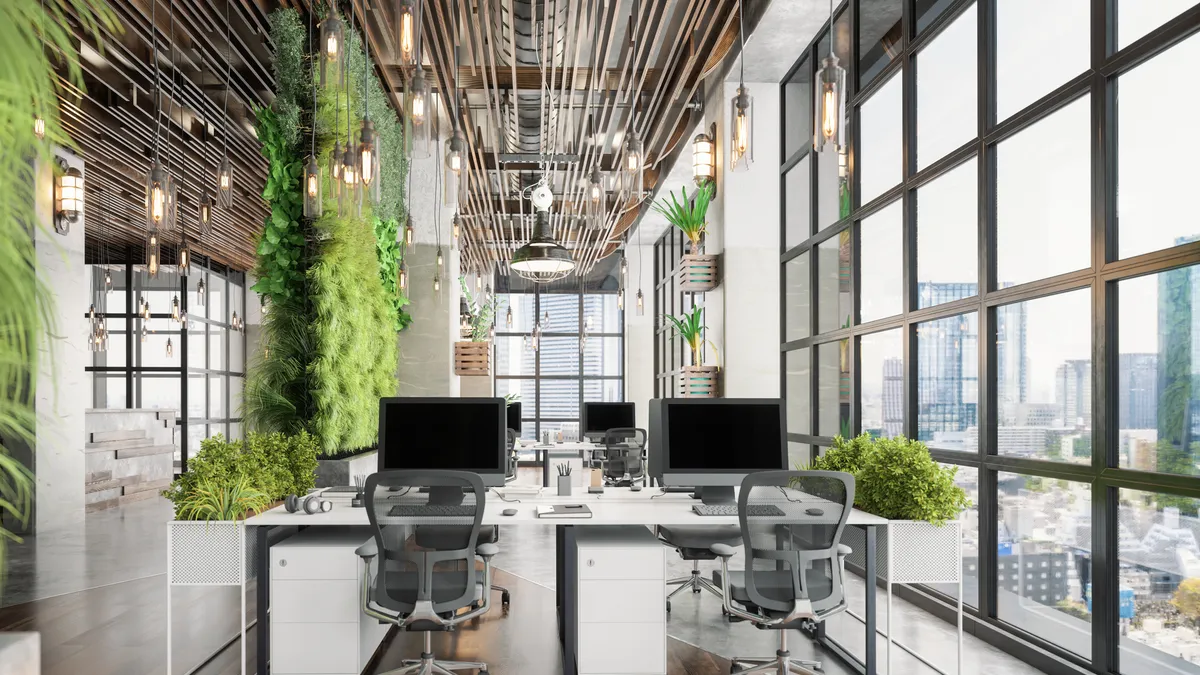Dive Brief:
-
Demand for sustainable buildings is surging, with tenants and occupiers willing to pay more for environmental performance indicators like energy intensity and electrification, according to a new report from JLL.
-
Yet, supply is struggling to keep pace. The real estate services firm’s Commercial Case for Making Sustainable Buildings report found that in 20 major office markets, only 34% of the demand for low-carbon workspaces will be satisfied in the coming years.
-
The business case for investing in decarbonization and resilience across real estate portfolios is “getting even stronger,” Guy Grainger, global head of sustainability services at JLL, said in a Nov. 28 news release. “Taking action now will minimize the business cost of ever more frequent climate events and maximize the commercial benefit from the incredibly low supply of net zero carbon buildings in the world."
Dive Insight:
The report outlined three long-term considerations that JLL recommends building owners and operators prioritize in decision-making against the backdrop of an economic environment that has challenged investors and occupiers to invest in green measures.
-
The rising demand for sustainable buildings. The demand surge comes as corporations increasingly pledge to reach net-zero targets and minimize operating costs, with green certifications becoming less of a differentiator and more of a requirement, the report states.
An increased focus on sustainability is impacting locations where aging building stock is “unlikely to comply with future regulations or expectations,” JLL said. The gap between expected demand for sustainable workspaces and current pipeline projects equates to an overall demand surplus of 109.8 million square feet of low-carbon office space across the 20 markets the firm studied. That translates to just one square meter in the current development pipeline, for every three square meters of demand, JLL said.
This has led to a 7.1% average rental premium for green-certified, class A office buildings across eight major markets in the U.S. and Canada, JLL said.
-
The mounting costs of climate risk. Heat waves, floods, storms and droughts have major implications for building owners as they disrupt operations, drive worker shortages and cause damage to buildings and infrastructure, resulting in higher operating costs for companies that have failed to adopt appropriate mitigation measures, JLL said.
Estimates from nonprofit First Street Foundation and engineering firm Arup, suggest that the annual costs stemming from flood damage in the U.S. will amount to $16.9 billion by 2052. However, climate risk “remains a blind spot” for some companies, JLL said, pointing to a decarbonization study it conducted last year, which found that 83% of occupiers identify climate issues as a financial risk, while a 2023 PwC Pulse Survey discovered that only 23% of executives are developing contingency plans for climate-based disruptions in the next 12 to 18 months.
-
More stringent regulations. Companies operating across multiple cities will need to stay on top of incoming and evolving policies to avoid financial penalties and reputational damage, the report states.
Potential outcomes highlighted by JLL include increasingly expensive funding terms for assets which fall short of evolving standards, higher insurance premiums for non-resilient buildings or those in vulnerable locations and more complicated long-term capital planning as physical risks become more predictable. By implementing “the right measures in the right way at the right time,” the report says that owners can minimize the impact of physical and transition risks on their buildings.
To slash emissions and boost resiliency, the report suggests that building owners and operators procure offsite green energy, generate onsite green energy, decarbonize energy supplies, implement retrofits to optimize the energy efficiency of assets and optimize operational efficiency and carbon accounting. The firm also recommends better insulation to reduce heat gain or loss, cooling features like external shutters and blinds and materials that alter the amount of heat absorbed and reflected depending on outside air temperature.
JLL expressed optimism about the potential for microgrids to help cities meet higher power demands and distribute power locally to connected buildings independent of the main electrical grid.












